The best astrophotography stacking software includes free options like DeepSkyStacker (Windows), Siril (cross-platform), and paid professional tools like PixInsight (all platforms). Your choice depends on your budget, operating system, and skill level. DeepSkyStacker offers user-friendly design for beginners, while PixInsight provides advanced processing tools with a steeper learning curve. Siril strikes a balance with cross-platform flexibility and strong documentation. The right software can transform your celestial captures into stunning cosmic portraits.
Numeric List of 10 Second-Level Headings

When organizing your exploration of astrophotography stacking applications, you'll need a clear structure to navigate the various options effectively.
A structured approach is essential when navigating the crowded landscape of astrophotography stacking software.
Consider these ten key headings for your comparison:
- Price Points and Value Assessment
- Platform Compatibility (Windows/Mac/Linux)
- User Interface and Learning Curve
- Processing Speed and Performance
- File Format Support
- Advanced Features for Deep Sky Objects
- Planetary Imaging Capabilities
- Nightscape and Foreground Integration
- Technical Support and Community Resources
- Integration with Other Astrophotography Tools
These categories will help you systematically evaluate each program's strengths and limitations.
Whether you're prioritizing cost-effectiveness with free options like Siril, seeking MacOS compatibility with Starry Landscape Stacker, or needing the advanced capabilities of PixInsight, this framework guarantees you'll make an informed decision. The quality of signal-to-noise ratio significantly impacts your final image quality, making it an essential consideration when selecting stacking software.
DeepSkyStacker: The Entry-Level Star Stacker for Windows Users
Among the many astrophotography stacking options available today, DeepSkyStacker stands out as the go-to solution for Windows users taking their first steps into deep sky imaging.
The latest version 5.1.0 runs on 64-bit Windows 10 and later, with improved processing speed thanks to SIMD optimization and enhanced multithreading.
You'll appreciate the reworked interface with undockable panels and the blink comparator that caches twenty images for quick comparison. The software now stores its settings in a new registry hive located at HKCU\Software\DeepSkyStacker\DeepSkyStacker5.
DeepSkyStacker handles various file formats, including RAW and FIT files from astronomy cameras, while offering multiple registration and stacking methods.
What makes this software particularly accessible is its user-friendly design coupled with detailed image scoring to help you select ideal frames.
It's an excellent complement to other astrophotography tools in your workflow.
PixInsight: Professional-Grade Processing for Serious Astrophotographers

PixInsight offers you advanced workflow capabilities that stretch far beyond simple stacking with its extensive suite of calibration, alignment, and processing tools.
You'll need to invest significant time mastering its interface, as the professional-grade software presents one of the steepest learning curves in astrophotography processing.
Its powerful scripting features allow you to automate complex processing sequences through JavaScript, making repetitive tasks more efficient once you've conquered the initial complexity. The software's SubframeSelector feature helps grade images based on criteria like star sharpness, ensuring only the highest quality frames are included in your final stack.
Advanced Workflow Capabilities
Serious astrophotographers who've outgrown basic stacking tools will find PixInsight's workflow capabilities revolutionary for their imaging projects. The platform's module-based operations use process icons that encapsulate complex functions into manageable, configurable elements.
You'll appreciate the JavaScript-based scripting system that automates repetitive tasks across large datasets. Your processes can be saved as XML files for reuse across multiple projects, ensuring consistency in your workflow.
The customizable workspace lets you create dedicated environments for different processing stages. Power users can take advantage of the built-in HDR wavelet transform algorithms to reveal details in both bright and dark regions of astronomical images simultaneously.
When collaborating or working across devices, you can save entire projects as transportable bundles of XML files and binary data. This preservation of processing states means you can return to any stage of your work, something particularly valuable when refining complex deep-sky images through multiple iterations.
Steep Learning Curve
Despite its powerful workflow capabilities, the path to mastering PixInsight isn't smooth. The software's complexity and sometimes inadequate documentation create significant hurdles for beginners. You'll likely face challenges with direct color data application, often leading to unpredictable results. Many users benefit from following a logical approach that builds knowledge progressively from fundamental concepts to advanced techniques.
| Learning Aspect | Beginner | Advanced User |
|---|---|---|
| Interface Navigation | Confusing | Intuitive |
| Documentation | Limited | Manageable |
| Processing Results | Unpredictable | Consistent |
While the EUR 300 price tag reflects PixInsight's professional-grade capabilities, you'll need dedication to justify the investment. Fortunately, the active user community provides tutorials and resources to help overcome these obstacles. Consider starting with structured learning approaches, breaking down skills into foundational pieces, and practicing with sample data before tackling your own astrophotography projects.
Powerful Script Features
While many stacking applications offer basic functionality, PixInsight's true power lies in its extensive script ecosystem that dramatically expands its capabilities.
You'll find specialized tools like "What's in My Image" that identifies celestial objects using Simbad and Aladin databases, and "Blind Solver 2000" for seamless astrometry integration. The "What's in My Image" script features a mini-preview window that allows users to quickly navigate their images while searching for celestial objects.
The star reduction script lets you minimize large stars while protecting smaller ones, enhancing your image aesthetics.
For workflow optimization, you can utilize batch processing to automate repetitive tasks and take advantage of gradient descent for dynamic background extraction to remove light pollution.
Advanced users will appreciate the Supernova & Asteroid Hunter for detecting anomalies, and tools like Halo-B-Gon for reducing star halos.
These scripts integrate seamlessly into the platform, continuously updated through the community repository.
Siril: Open-Source Alternative With Cross-Platform Flexibility

Siril stands out as a powerful open-source astrophotography tool that won't cost you a penny while offering compatibility across Windows, macOS, and Linux systems.
You'll find its core features impressive, including automatic image alignment, extensive format support, and advanced calibration techniques for professional-quality results.
Installing Siril on your preferred platform is straightforward, with pre-compiled binaries available for all major operating systems and detailed documentation to guide you through the setup process. The software natively processes images in 32-bit FITS format while also supporting the SER format preferred by many planetary imagers.
Siril's Core Features
As an open-source powerhouse in the astrophotography domain, Siril offers an extensive suite of features that rival its commercial counterparts. You'll find thorough pre-processing tools, including dark, flat, and bias frame calibration to clean unwanted signals from your astro images. The software works internally with 32-bit FITS format natively, offering exceptional dynamic range for processing astronomical data.
| Feature Category | What You Get |
|---|---|
| Image Processing | Histogram transformation, color calibration, gradient removal |
| Stacking | Advanced registration, outlier rejection, SNR enhancement |
| Scientific Tools | Photometric analysis, astrometry integration, data extraction |
| Automation | Custom scripting, console mode, workflow optimization |
Siril excels at handling FITS and SER formats while providing robust alignment algorithms through OpenCV integration. The software's ability to automate complex processes through custom scripts makes it particularly valuable for both beginners and experienced astrophotographers seeking control without cost barriers.
Cross-Platform Installation Guide
One of the most compelling advantages of Siril is its genuine cross-platform flexibility, making it accessible regardless of your operating system preference. Installation is straightforward across all major platforms.
For Linux users, package managers make the process seamless: Ubuntu/Debian users can run 'sudo apt install siril', while Fedora users should use 'sudo dnf install siril', and Arch Linux users can install with 'sudo pacman -S siril'.
If you're on Windows or Mac, simply download the installer from Siril's official website (https://siril.org/). Mac users can enhance functionality by integrating scripts like StarNet for advanced processing capabilities.
The consistent user interface across platforms guarantees a smooth changeover if you switch operating systems, while the open-source community provides robust support through detailed documentation and active forums. Installation of additional stacking scripts may be required for specific file formats like Dwarf 3 .fits files.
Sequator: Streamlined Stacking for Wide-Field Astrophotography
Night sky photographers seeking simplicity will find Sequator to be an invaluable tool in their astrophotography arsenal. This free Windows-only program excels at stacking wide-field images, particularly those including landscape foregrounds.
You'll appreciate Sequator's intuitive process—simply select your images, choose a base frame (or let it default to the middle image), and add optional dark frames to reduce hot pixels. The software automatically detects sky regions, allowing accurate alignment while preserving static foregrounds.
Unlike complex alternatives, Sequator offers powerful features without the learning curve. It handles RAW and DNG formats, reduces distortion, adjusts for light pollution, and supports star trails creation. Sequator processes stacks significantly faster, completing a 10-image stack in about 1 minute compared to Photoshop's 3 minutes for similar quality results.
Powerful yet simple, Sequator handles complex astrophotography tasks without overwhelming users.
When you're done, export your work as 16-bit TIFF for further editing or 8-bit JPEG for immediate sharing.
AstroPixel Processor: Premium Mosaic-Making Capabilities

While many stacking programs focus on basic alignment, AstroPixel Processor (APP) stands out as a premium solution for astrophotographers seeking professional-grade mosaic capabilities.
APP excels at combining images from different cameras and sources, making it perfect for collaborative projects. Its advanced image registration offers true optical distortion correction, ensuring seamless stitching without pinched stars. The Local Normalization Correction feature intelligently matches backgrounds between panels. The software uses Multi-Band Blending techniques to eliminate stack artifacts and visible seams in mosaic integrations.
Beyond mosaics, APP delivers all-encompassing pre-processing with calibration frames and bad pixel mapping. You'll navigate through a numbered menu system with helpful tooltips guiding your workflow.
The software lets you control RAM usage and CPU utilization for peak performance.
Available in owner or renter licensing options, APP requires substantial system resources but delivers professional results worth the investment.
RegiStax 6: Specialized Planetary and Lunar Stacking
RegiStax 6 stands out with its powerful wavelet processing that lets you enhance fine details in planetary and lunar images through customizable layers.
You'll benefit from its robust alignment algorithm that precisely stacks multiple frames, even with atmospheric turbulence present.
After stacking, you can use RegiStax's extensive enhancement tools to fine-tune brightness, contrast, and color balance for stunning final results. The software's histogram tool allows you to adjust mid-point and contrast levels to optimize different areas of your astronomical image.
Wavelet Processing Capabilities
Among the most powerful features in RegiStax 6, wavelet processing stands out for its ability to transform ordinary planetary and lunar images into stunning, detail-rich photographs.
You'll find extensive control through its linked wavelet layers, where each layer can be precisely adjusted with specific denoise and sharpen settings. The software excels at revealing intricate details through Gaussian Sharpen filter adjustments.
What makes this system exceptional is how you can enhance fine details while simultaneously managing noise levels. The multicore processing support guarantees you won't waste time waiting for results, though remember that larger processing areas require more time but deliver more thorough enhancements.
You can save your preferred wavelet schemes for consistent processing across multiple images, and even utilize batch processing for efficiency.
For specialized needs, the advanced controls offer precise adjustments that competitors like AutoStakkert don't match.
Alignment Algorithm Strengths
The backbone of RegiStax 6's exceptional performance lies in its sophisticated alignment algorithms designed specifically for planetary and lunar stacking.
You'll benefit from the powerful Alignpoint Estimation that grades up to 2000 points from weak to strong based on intensity and distance, ensuring precise frame matching.
The software's Multi-Core Processing capability harnesses up to 8 CPU cores simultaneously, greatly reducing processing time for large datasets.
What sets RegiStax apart is its combined Optimization and Alignment module that tracks alignpoints even in low-contrast areas, eliminating separate optimization steps.
RegiStax 6 features a completely redesigned interface for improved workflow efficiency and more intuitive operation.
Detail Enhancement capabilities considerably improve image quality while reducing noise.
Additional features include automatic detection for large AVI files, batch processing, and region-of-interest capabilities for precise alignment control.
Post-Stack Enhancement Tools
After stacking your planetary or lunar images, RegiStax 6 truly shines with its powerful enhancement capabilities.
The software's Linked Wavelet Layers let you reveal fine details in planets and lunar features that might otherwise remain hidden in your raw stacks.
You'll find three standout features that make RegiStax 6 particularly valuable:
- Wavelets system – Divides image processing into layers, allowing precise control over different detail scales
- Independent denoise filters – Apply noise reduction to each wavelet layer separately, preserving details while removing noise
- Automatic recalculation – See immediate feedback as you adjust settings, though this can be resource-intensive with larger files
This wavelet processing approach allows individual layer adjustments with the default Denoise filters set to 0.00.
Best of all, RegiStax 6 is completely free, making it accessible for beginners and experienced astrophotographers alike.
StarStax: Simple Star Trail Processing on Any Budget
Renowned for its simplicity and accessibility, StarStaX has established itself as a go-to application for astrophotographers seeking to create enchanting star trails without breaking the bank. Available free on Mac, Windows, and Linux, this cross-platform tool supports JPEG, TIFF, bitmap, and PNG formats.
You'll appreciate StarStaX's intuitive drag-and-drop interface that makes stacking multiple images effortless. The software excels at noise reduction and exposure enhancement through image stacking, while its comet mode creates distinctive trail effects. Though the interface may appear small on high-resolution displays, the workflow remains straightforward. Its powerful ability to combine multiple stills into one composite image is what makes it particularly valuable for star trail photography.
Beyond star trails, you can use StarStaX for light painting enhancements and creative blending effects. With regular updates and compatibility with newer hardware like M1 Macs, it's a versatile tool for both beginners and experienced astrophotographers.
Comparing Free vs. Paid Stacking Software: Is the Investment Worth It?

While StarStaX offers elegant simplicity for star trail creation, many astrophotographers face a more complex decision when selecting software for deep-sky image stacking.
StarStaX simplifies star trails, but deep-sky stackers face tougher software choices balancing simplicity against power.
The debate between free options like DeepSkyStacker and Siril versus paid software like PixInsight involves balancing capability with cost.
When making your decision, consider these key factors:
- Learning curve vs. capabilities – Free software offers user-friendly interfaces for beginners, while paid options provide advanced features but require more time to master.
- Processing speed – Siril outperforms many alternatives, including some paid options, making it ideal if you're processing large datasets.
- Long-term needs – For casual astrophotography, free software provides sufficient functionality, but serious enthusiasts may find paid software's advanced features justify the investment over time. Tools like Deep Sky Stacker have become essential for stacking multiple exposures to enhance signal-to-noise ratio in astronomical images.
Operating System Compatibility: Finding the Right Software for Your Setup
Choosing the right astrophotography stacking software depends considerably on your computer's operating system.
If you're a Windows user, you'll have the most options, with DeepSkyStacker, RegiStax, and Siril all running natively.
Mac users should consider Starry Landscape Stacker (macOS exclusive) or cross-platform options like Siril and AstroPixel Processor.
DeepSkyStacker requires Bootcamp or virtualization on Macs, which might impact performance.
Linux enthusiasts can rely on Siril and AstroPixel Processor for native support, while RegiStax can run using Wine.
For serious astrophotographers seeking professional results, PixInsight offers comprehensive tools across all major platforms at a premium price of EUR 300 plus VAT.
When selecting software, consider file format compatibility—DeepSkyStacker handles RAW, TIFF, and FITS, while Siril accepts these plus SER, AVI, and PNG formats.
Your choice should ultimately balance OS compatibility with your specific imaging needs.
Frequently Asked Questions
Can Stacking Software Fix Tracking Errors in My Mount?
Stacking software can fix minor tracking errors in your mount by aligning and combining frames, but it can't correct significant issues. For best results, you'll still need proper mount alignment and calibration.
How Many Frames Should I Stack for Optimal Results?
You'll typically get ideal results with 20-50 frames. More frames reduce noise better, but beyond 50, you'll see diminishing returns. Your specific target and equipment may require adjustments to this range.
Will Stacking Improve Images Taken in Light-Polluted Areas?
Yes, stacking will improve your light-polluted images by reducing noise and enhancing signal. You'll see better results when you combine this technique with shorter exposures and appropriate software for gradient removal.
Can Smartphone Astrophotography Benefit From Stacking Software?
Yes, your smartphone astrophotography can greatly benefit from stacking software. It'll reduce noise, enhance faint details, and improve dynamic range, helping overcome the limitations of small smartphone sensors in low-light conditions.
Is GPU Acceleration Important When Choosing Stacking Software?
Yes, GPU acceleration is important if you're processing large datasets or need fast results. It'll drastically reduce your processing time from minutes to seconds, especially with advanced software like PixInsight.
In Summary
You'll find the perfect stacking software depends on your specific needs and budget. Whether you're just starting out with DeepSkyStacker or ready for PixInsight's advanced capabilities, there's an option for every skill level. Consider your operating system, target objects, and desired workflow when choosing. Don't be afraid to try several programs—many offer free trials or are completely open-source, letting you discover what works best for your astrophotography journey.
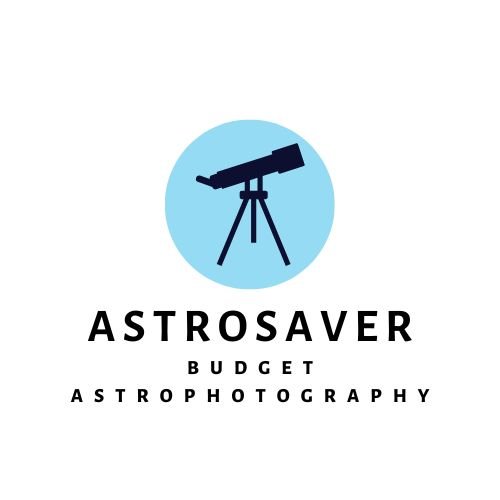
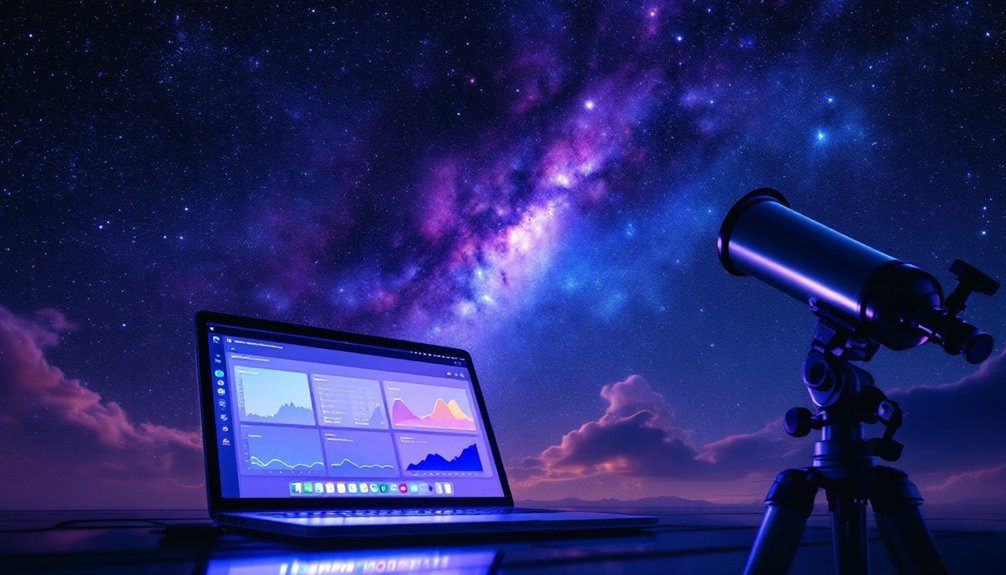
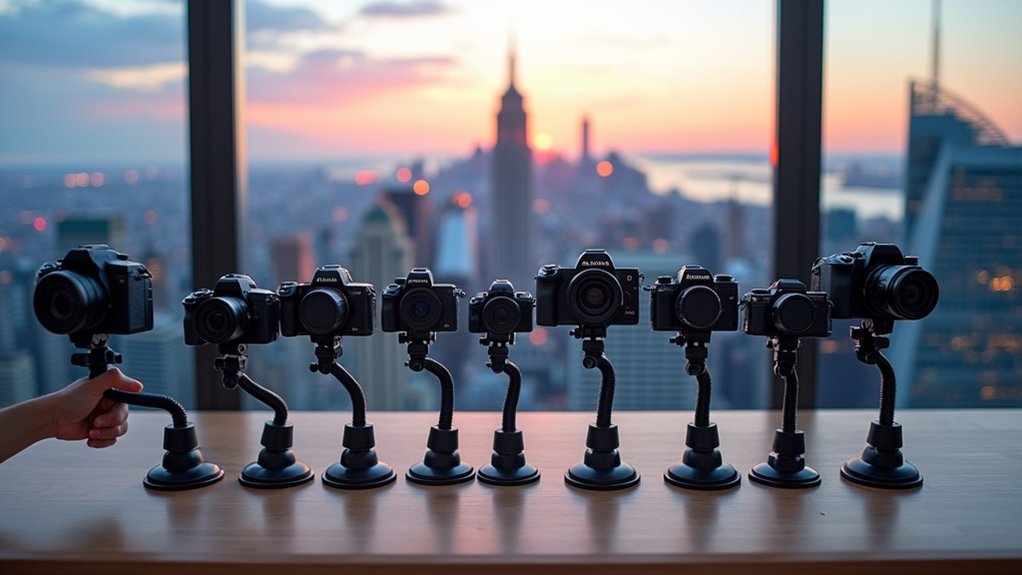
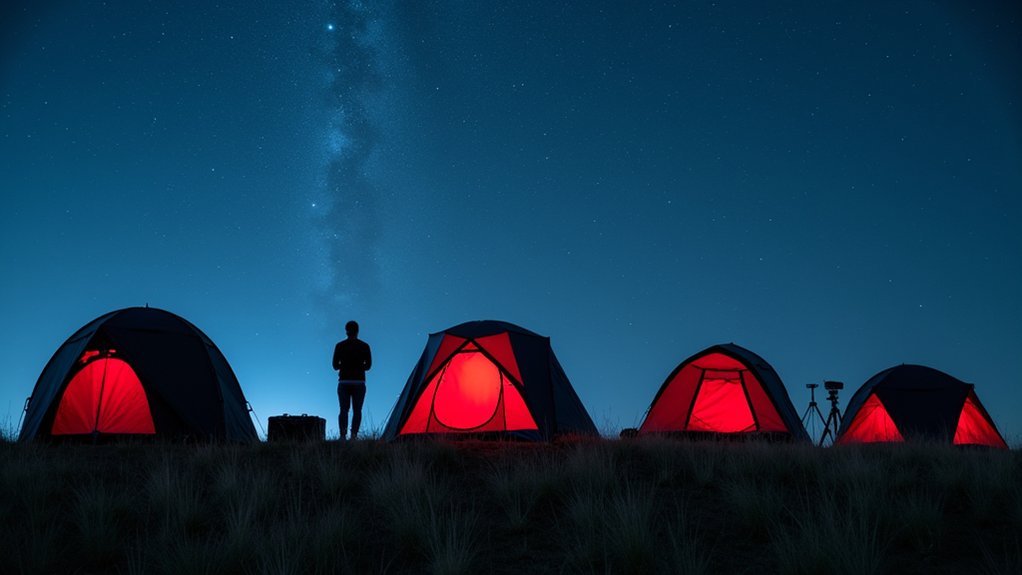
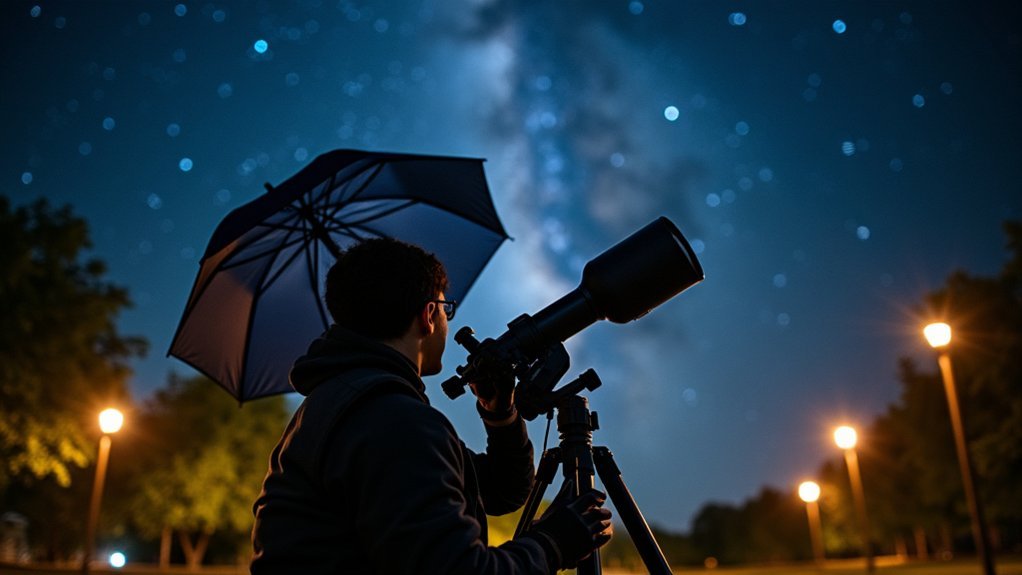
Leave a Reply